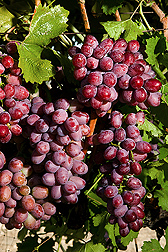This page has been archived and is being provided for reference purposes only. The page is no longer being updated, and therefore, links on the page may be invalid.
Read the magazine story to find out more. |
|
"Scarlet Royal" Grapes: Delicious!
By Marcia WoodApril 7, 2006
If you love sweet, firm grapes, you'll want to try Scarlet Royal red seedless from Agricultural Research Service (ARS) grape breeders in California.
Young vines that will yield this delicious, oval-shaped grape already flourish in sunny vineyards in California, the nation's largest producer of fresh-market, wine and raisin grapes. And though Scarlet Royal vines won't be ready to harvest for another few years, their luscious grapes are well worth the wait.
That's according to ARS horticulturist David W. Ramming and colleague Ronald E. Tarailo, who developed Scarlet Royal and tested it for 10 years before determining, in 2005, that it was ready for commercial vineyards. They received a U.S. patent for the grape in January 2006.
Ramming and Tarailo are with ARS' San Joaquin Valley Agricultural Sciences Center at Parlier, Calif., about 200 miles north of Los Angeles.
Scarlet Royal grapes have attractive, dark-red skin and translucent, pale yellow-green flesh. By ripening in mid-August, the grapes help fill the gap between the earlier-ripening Flame Seedless, America's favorite red seedless grape, and the later-ripening Crimson Seedless.
Scarlet Royal, Flame Seedless and Crimson Seedless have all resulted from ARS' grape-breeding program in California, now in its 83rd year.
One of the newer grapes from the team, Scarlet Royal likely wouldn't exist were it not for an exacting laboratory procedure called embryo rescue. Ramming pioneered the application of this technology for breeding seedless grapes.
The approach requires excising the tiny, wisp-like embryo from inside a promising seedless grape, then nurturing it with special nutrients, in petri dishes, to form a little seedling.
In nature, when two seedless grape plants are chosen as parents—as was the case for Scarlet Royal—their offspring usually produce grapes with embryos so minuscule that they can't survive without the help of embryo rescue procedures.
Read more about the research in the April 2006 issue of Agricultural Research magazine.
ARS is the U.S. Department of Agriculture's chief scientific research agency.

